Paper Menu >>
Journal Menu >>
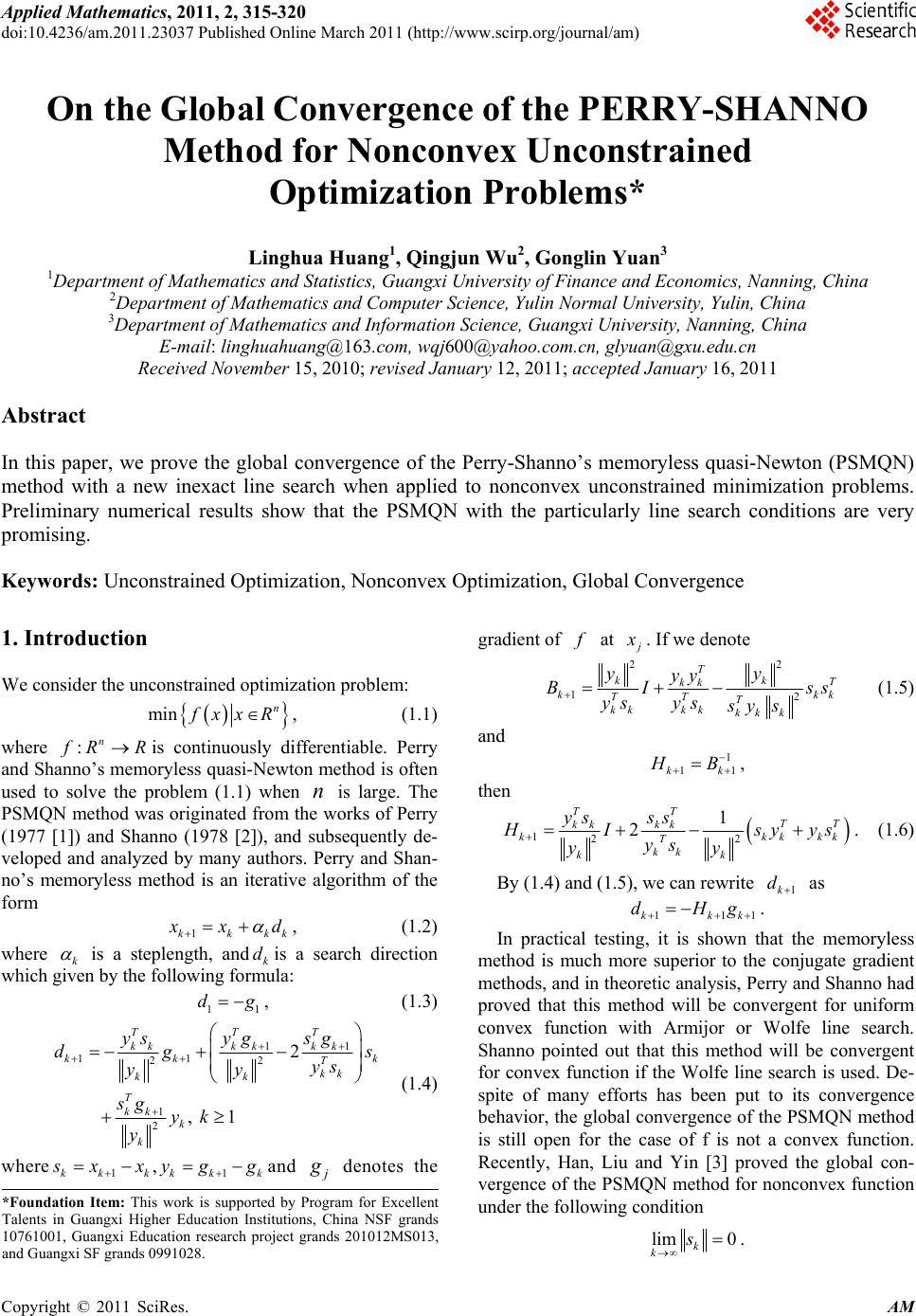 Applied Mathematics, 2011, 2, 315-320 doi:10.4236/am.2011.23037 Published Online March 2011 (http://www.scirp.org/journal/am) Copyright © 2011 SciRes. AM On the Global Convergence of the PERRY-SHANNO Method for Nonconvex Unconstrained Optimization Problems* Linghua Huang1, Qingjun Wu2, Gonglin Yuan3 1Department of Mathematics and Statistics, Guangxi University of Finance and Economics, Nanning, China 2Department of Mat hemat i cs an d C om p ut er Scie nce, Yul i n Norm al University, Yulin, China 3Department of Mat hem ati c s an d I nformation Science, Gu a ngxi University, Nannin g, C hi na E-mail: linghuahuang@163.com, wqj600@yahoo.com.cn, glyuan@gxu.edu.cn Received November 15, 2010; revised January 12, 2011; accepted Janu ary 16, 2011 Abstract In this paper, we prove the global convergence of the Perry-Shanno’s memoryless quasi-Newton (PSMQN) method with a new inexact line search when applied to nonconvex unconstrained minimization problems. Preliminary numerical results show that the PSMQN with the particularly line search conditions are very promising. Keywords: Unconstrained Optimization, Nonconvex Optimization, Global Convergence 1. Introduction We consider the unconstrained optimization problem: min n f xx R, (1.1) where :n f RRis continuously differentiable. Perry and Shanno’s memor yless quasi-Newton method is often used to solve the problem (1.1) when n is large. The PSMQN method was originated from the works of Perry (1977 [1]) and Shanno (1978 [2]), and subsequently de- veloped and analyzed by many authors. Perry and Shan- no’s memoryless method is an iterative algorithm of the form 1kkkk x xd , (1.2) where k is a steplength, andk dis a search direction which given by the following formula: 11 dg , (1.3) 11 11 22 1 2 2 , 1 TTT kkkk kk kk k T kk kk T kk k k ysyg sg dg s ys yy sg yk y (1.4) where 11 , kkkkkk s xxygg and j g denotes the gradient of f at j x . If we denote 22 12 T kk T kk kkk TT T kkkk kk k yy yy BI ss ysys sy s (1.5) and 1 11kk H B , then 122 1 2 TT TT kk kk kkkkk T kk kk ys ss H Isyys ys yy . (1.6) By (1.4) and (1.5), we can rewrite 1k d as 111kkk dHg . In practical testing, it is shown that the memoryless method is much more superior to the conjugate gradient methods, and in theoretic analysis, Perry and Shanno had proved that this method will be convergent for uniform convex function with Armijor or Wolfe line search. Shanno pointed out that this method will be convergent for convex function if the Wolfe line search is used. De- spite of many efforts has been put to its convergence behavior, the global convergence of the PSMQN method is still open for the case of f is not a convex function. Recently, Han, Liu and Yin [3] proved the global con- vergence of the PSMQN method for nonconvex function under the following condition lim 0 k ks . *Foundation Item: This work is supported by Program for Excellen t Talents in Guangxi Higher Education Institutions, China NSF grands 10761001, Guangxi Education research project grands 201012MS013, and Guan g xi SF g rands 0991028. 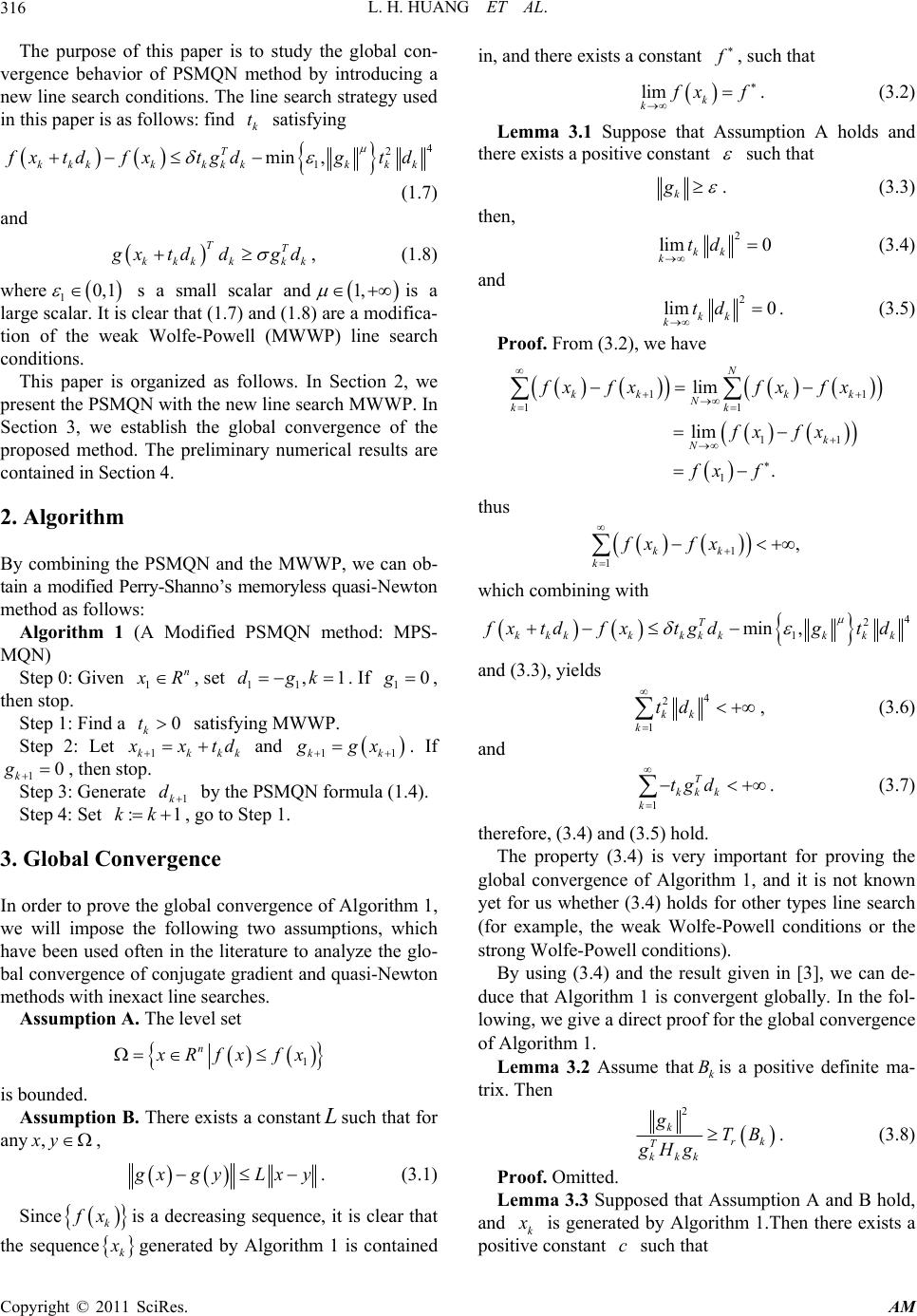 L. H. HUANG ET AL. Copyright © 2011 SciRes. AM 316 The purpose of this paper is to study the global con- vergence behavior of PSMQN method by introducing a new line search cond itions. The line search strategy used in this paper is as follows: find k t satisfying 4 2 1 min , T kkkkkkkk kk f xtdfxtgdg td (1.7) and TT kkk kkk g xtd dgd , (1.8) where 10,1 s a small scalar and 1, is a large scalar. It is clear that (1.7) and (1.8) are a modifica- tion of the weak Wolfe-Powell (MWWP) line search conditions. This paper is organized as follows. In Section 2, we present the PSMQN with the ne w line s ear ch MW WP. In Section 3, we establish the global convergence of the proposed method. The preliminary numerical results are containe d in Secti on 4. 2. Algorithm By combining the PSMQN and the MWWP, we can ob- tain a modified Perry-Shanno’s memoryless quasi-Newton method as follows: Algorithm 1 (A Modified PSMQN method: MPS- MQN) Step 0: Given 1n x R, set 11 ,1dgk . If 10g , then stop. Step 1: Find a 0 k t satisfying MWWP. Step 2: Let 1kkkk x xtd and 11kk ggx . If 10 k g, then stop. Step 3: Genera t e 1k d by the PSMQN formula (1.4). Step 4: Set :1kk, go to Step 1. 3. Global Convergence In order to prove the global convergence of Algorithm 1, we will impose the following two assumptions, which have been used often in the literature to analyze the glo- bal convergence of conjugate gradient and quasi-Newton methods with inexact line searches. Assumption A. The level set 1 n x Rfx fx is bounded. Assumption B. There exists a constantLsuch that for any ,xy, g xgy Lxy. (3.1) Since k f xis a decreasing sequence, it is clear that the sequence k x generated by Algorithm 1 is contained in, and there exists a constant f , such that lim k k f xf . (3.2) Lemma 3.1 Suppose that Assumption A holds and there exists a positive constant such that k g . (3.3) then, 2 lim 0 kk ktd (3.4) and 2 lim 0 kk ktd . (3.5) Proof. From (3.2), we have 11 11 11 1 lim lim . N kk kk N kk k N fx fxfx fx fx fx fx f thus 1 1, kk k fx fx which combining with 4 2 1 min , T kkkkkkkk kk f xtdfxtgdg td and (3.3), yields 4 2 1kk k td , (3.6) and 1 T kkk k tgd . (3.7) therefore, (3.4) and (3 .5 ) hold. The property (3.4) is very important for proving the global convergence of Algorithm 1, and it is not known yet for us whether (3.4) holds for other types line search (for example, the weak Wolfe-Powell conditions or the strong Wolfe-Powell conditions). By using (3.4) and the result given in [3], we can de- duce that Algorithm 1 is convergent globally. In the fol- lowing, we give a direct proof for the global convergence of Algorithm 1. Lemma 3.2 Assume thatk Bis a positive definite ma- trix. Then 2 krk T kkk gTB gHg. (3.8) Proof. Omitted. Lemma 3.3 Supposed that Assumption A and B hold, and k x is generated by Algorithm 1.Then there exists a positive constant c such that 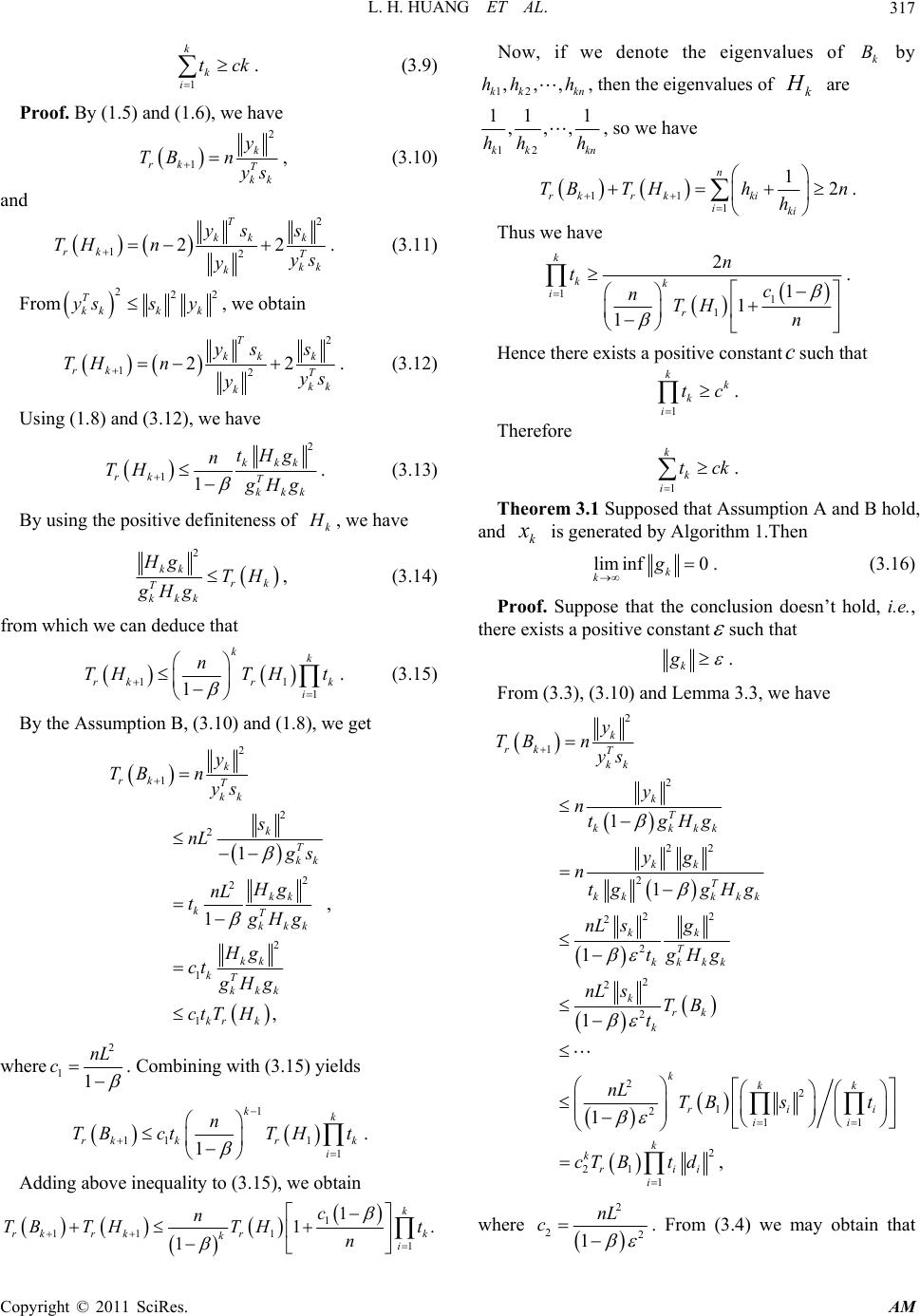 L. H. HUANG ET AL. Copyright © 2011 SciRes. AM 317 1 k k i tck . (3.9) Proof. By (1.5) and (1.6), we have 2 1k rk T kk y TBn ys , (3.10) and 2 12 22 T kk k rk T kk k ys s TH nys y . (3.11) From 222 T kkk k yss y, we obtain 2 12 22 T kk k rk T kk k ys s TH nys y . (3.12) Using (1.8 ) and (3.1 2), we have 2 11 kkk rk T kkk tHg n TH g Hg . (3.13) By using the positiv e definiten e ss of k H , we have 2 kk rk T kkk Hg TH gHg, (3.14) from which we can deduce that 11 1 1 kk rkr k i n THTH t . (3.15) By the Assumption B, (3.10) and (1.8), we get 2 1 2 2 2 2 2 1 1 1 1 , k rk T kk k T kk kk kT kkk kk kT kkk kr k y TB n ys s nL g s Hg nL t g Hg Hg ct gHg ctT H , where 2 11 nL c . Combining with (3.15) yields 1 11 1 1 1 kk rk krk i n TBctTH t . Adding above inequality to (3.15), we obtain 1 11 11 1 1. 1 k rkr krk ki c n TB THTHt n Now, if we denote the eigenvalues of k B by 12 ,,, kk kn hh h, then the eigenvalues of k H are 12 11 1 ,,, kk kn hh h , so we have 11 1 12 n rkr kki iki TB THhn h . Thus we have 11 1 2 1 1 1 k kk i r n tc nTH n . Hence there exists a positive constantcsuch that 1 kk k i tc . Therefore 1 k k i tck . Theorem 3.1 Supposed that Assumption A and B hold, and k x is generated by Algo ri t h m 1.Then lim inf0 k kg . (3.16) Proof. Suppose that the conclusion doesn’t hold, i.e., there exists a positive constant such that k g . From (3.3), (3.10) and Lemma 3.3, we have 2 1 2 22 2 22 2 2 2 2 2 22 1 211 2 21 1 1 1 1 1 1 , k rk T kk k T kkkk kk T kk kkk kk T kkkk krk k kkk rii ii k krii i y TB n ys y ntgHg yg ntg gHg nL sg tgHg nL sTB t nL TB st cTBtd where 2 22 1 nL c . From (3.4) we may obtain that 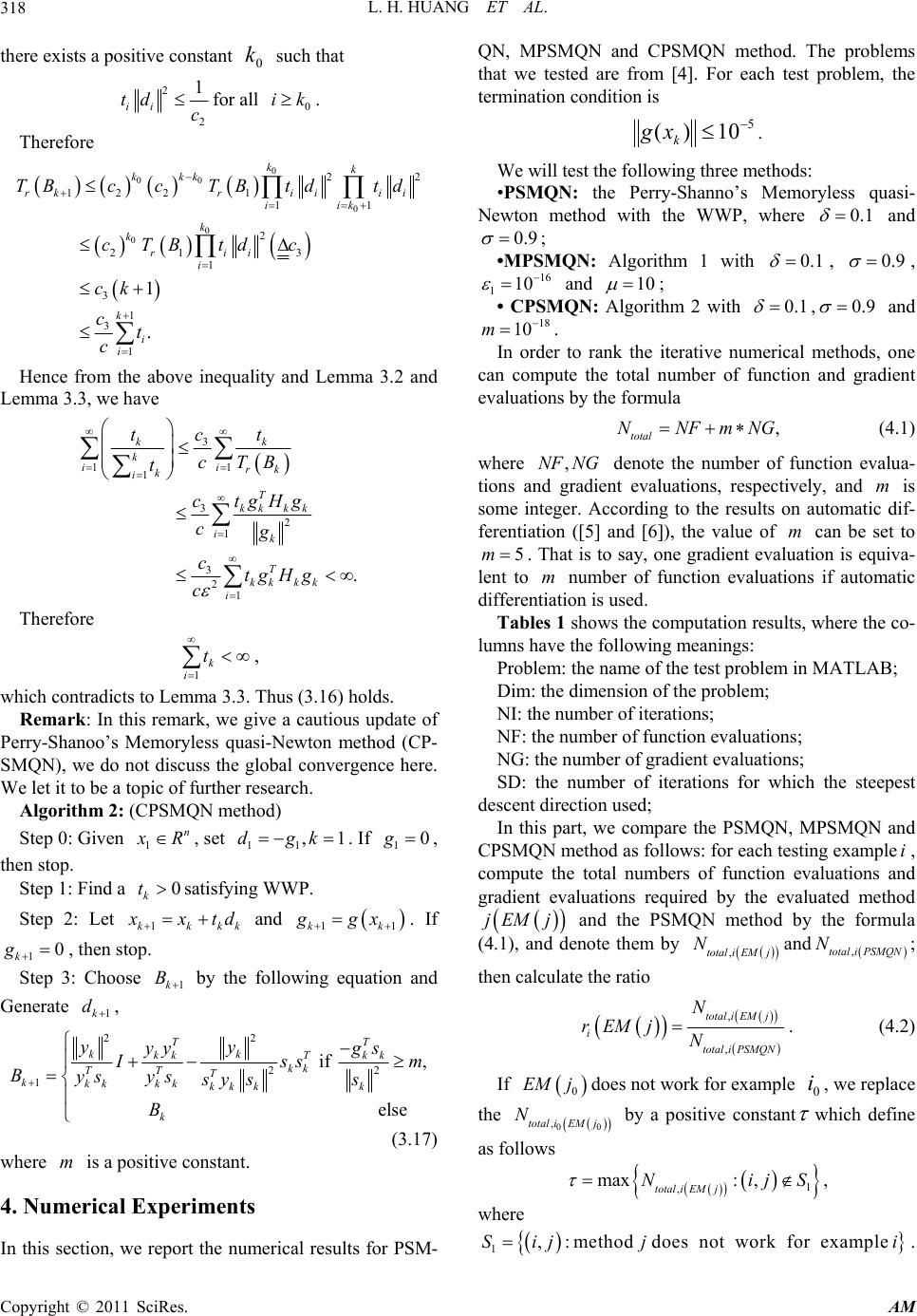 L. H. HUANG ET AL. Copyright © 2011 SciRes. AM 318 there exists a positive cons tant 0 k such that 2 2 1 ii td c for all 0 ik. Therefore 0 00 0 0 0 22 122 1 11 2 21 3 1 3 1 3 1 1 . kk kkk rkrii ii iik k k rii i k i i TBc cTB tdtd cTB tdc ck ct c Hence from the above inequality and Lemma 3.2 and Lemma 3.3, we have 3 11 1 32 1 321. kk k ii rk k i T kk kk ik T kk kk i tct cTB t ctgHg cg ctgHg c Therefore 1k i t , which contradicts to Lemma 3.3. Thus (3.16) holds. Remark: In this remark, we give a cautious update of Perry-Shanoo’s Memoryless quasi-Newton method (CP- SMQN), we do not discuss the global convergence here. We let it to be a topic of further research. Algorithm 2: (CPSMQN method) Step 0: Given 1n x R, set 11 ,1dgk . If 10g , then stop. Step 1: Find a 0 k tsatisfying WWP. Step 2: Let 1kkkk x xtd and 11kk ggx . If 10 k g, then stop. Step 3: Choose 1k B by the following equation and Generate 1k d, 22 22 1 if , else TT kk T kk kk kk TT T kkkkk kkkk k yy yy gs I ss m Bysys sy ss B (3.17) where m is a positive constant. 4. Numerical Experiments In this section, we report the numerical results for PSM- QN, MPSMQN and CPSMQN method. The problems that we tested are from [4]. For each test problem, the termination condition is 5 10)( k xg . We will test the following three methods: •PSMQN: the Perry-Shanno’s Memoryless quasi- Newton method with the WWP, where 0.1 and 0.9 ; •MPSMQN: Algorithm 1 with 0.1 , 0.9 , 16 110 and 10 ; • CPSMQN: Algorithm 2 with 0.1 ,0.9 and 18 10m . In order to rank the iterative numerical methods, one can compute the total number of function and gradient evaluations by t he formula , total NNFmNG (4.1) where ,NFNG denote the number of function evalua- tions and gradient evaluations, respectively, and m is some integer. According to the results on automatic dif- ferentiation ([5] and [6]), the value of m can be set to 5m . That is to say, one gradient evaluation is equiva- lent to m number of function evaluations if automatic different i a t i on i s used. Tables 1 shows th e computation results, where the co- lumns have the following meaning s : Problem: the name of the test problem in MATLAB; Dim: the dimension of the problem; NI: the number of iterations; NF: the number of function evaluations; NG: the number of g ra dient e valuations ; SD: the number of iterations for which the steepest descent direction used; In this part, we compare the PSMQN, MPSMQN and CPSMQN method as follows: for each testing ex amplei, compute the total numbers of function evaluations and gradient evaluations required by the evaluated method jEM j and the PSMQN method by the formula (4.1), and denote them by ,totaliEMj Nand ,total iPSMQN N; then calculate the ratio , , total iEMj i total iPSMQN N rEMj N . (4.2) If 0 EM jdoes not work for example 0 i, we replace the 00 ,total iEMj N by a positive constant which define as follows 1 , max: , total iEMj NijS , where 1,:Sijmethodjdoes not work for example i. 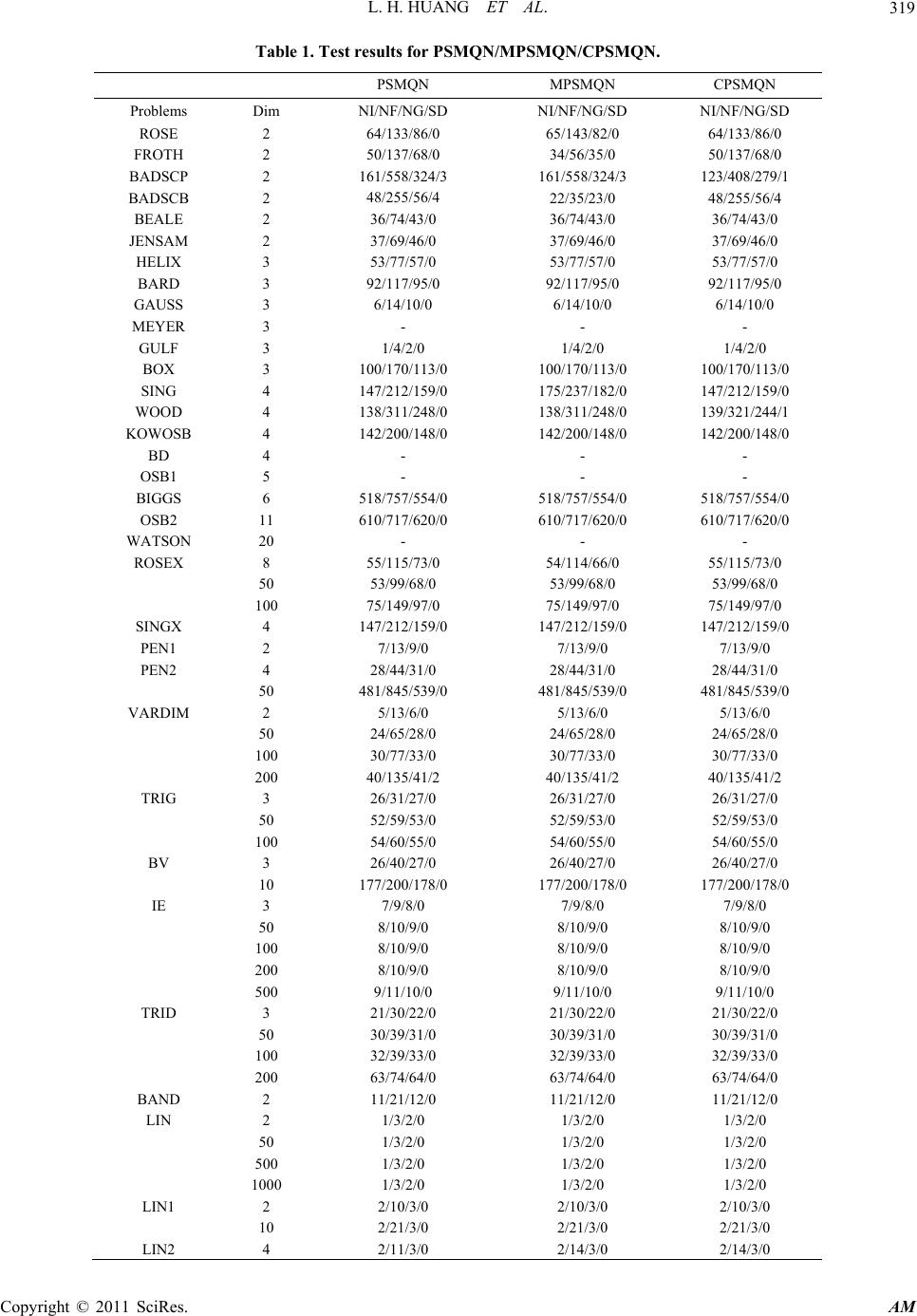 L. H. HUANG ET AL. Copyright © 2011 SciRes. AM 319 Table 1. Test results for PSMQN/MPSMQN/CPSMQN. PSMQN MPSMQN CPSMQN Problems Dim NI/NF/NG/SD NI/NF/NG/SD NI/NF/NG/SD ROSE FROTH BADSCP BADSCB BEALE JENSAM HELIX BARD GAUSS MEYER GULF BOX SING WOOD KOWOSB BD OSB1 BIGGS OSB2 WATSON ROSEX SINGX PEN1 PEN2 VARDIM TRIG BV IE TRID BAND LIN LIN1 LIN2 2 2 2 2 2 2 3 3 3 3 3 3 4 4 4 4 5 6 11 20 8 50 100 4 2 4 50 2 50 100 200 3 50 100 3 10 3 50 100 200 500 3 50 100 200 2 2 50 500 1000 2 10 4 64/133/86/0 50/137/68/0 161/558/324/3 48/255/56/4 36/74/43/0 37/69/46/0 53/77/57/0 92/117/95/0 6/14/10/0 - 1/4/2/0 100/170/113/0 147/212/159/0 138/311/248/0 142/200/148/0 - - 518/757/554/0 610/717/620/0 - 55/115/73/0 53/99/68/0 75/149/97/0 147/212/159/0 7/13/9/0 28/44/31/0 481/845/539/0 5/13/6/0 24/65/28/0 30/77/33/0 40/135/41/2 26/31/27/0 52/59/53/0 54/60/55/0 26/40/27/0 177/200/178/0 7/9/8/0 8/10/9/0 8/10/9/0 8/10/9/0 9/11/10/0 21/30/22/0 30/39/31/0 32/39/33/0 63/74/64/0 11/21/12/0 1/3/2/0 1/3/2/0 1/3/2/0 1/3/2/0 2/10/3/0 2/21/3/0 2/11/3/0 65/143/82/0 34/56/35/0 161/558/324/3 22/35/23/0 36/74/43/0 37/69/46/0 53/77/57/0 92/117/95/0 6/14/10/0 - 1/4/2/0 100/170/113/0 175/237/182/0 138/311/248/0 142/200/148/0 - - 518/757/554/0 610/717/620/0 - 54/114/66/0 53/99/68/0 75/149/97/0 147/212/159/0 7/13/9/0 28/44/31/0 481/845/539/0 5/13/6/0 24/65/28/0 30/77/33/0 40/135/41/2 26/31/27/0 52/59/53/0 54/60/55/0 26/40/27/0 177/200/178/0 7/9/8/0 8/10/9/0 8/10/9/0 8/10/9/0 9/11/10/0 21/30/22/0 30/39/31/0 32/39/33/0 63/74/64/0 11/21/12/0 1/3/2/0 1/3/2/0 1/3/2/0 1/3/2/0 2/10/3/0 2/21/3/0 2/14/3/0 64/133/86/0 50/137/68/0 123/408/279/1 48/255/56/4 36/74/43/0 37/69/46/0 53/77/57/0 92/117/95/0 6/14/10/0 - 1/4/2/0 100/170/113/0 147/212/159/0 139/321/244/1 142/200/148/0 - - 518/757/554/0 610/717/620/0 - 55/115/73/0 53/99/68/0 75/149/97/0 147/212/159/0 7/13/9/0 28/44/31/0 481/845/539/0 5/13/6/0 24/65/28/0 30/77/33/0 40/135/41/2 26/31/27/0 52/59/53/0 54/60/55/0 26/40/27/0 177/200/178/0 7/9/8/0 8/10/9/0 8/10/9/0 8/10/9/0 9/11/10/0 21/30/22/0 30/39/31/0 32/39/33/0 63/74/64/0 11/21/12/0 1/3/2/0 1/3/2/0 1/3/2/0 1/3/2/0 2/10/3/0 2/21/3/0 2/14/3/0  L. H. HUANG ET AL. Copyright © 2011 SciRes. AM 320 Table 2. Relative efficiency of PSMQN, MPSMQN and CPSMQN. PSMQN MPSMQN CPSMQN 1 0.9752 0.9963 The geometric mean of these ratios for method EM(j) over all the test problems is defined by 1S i iS rEM jrEM j , (4.3) where S denotes the set of the test problems and S the number of elements in S. One advan t ag e of the abo- ve rule is that, the comparison is relative and hence does not be dominated by a few problems for which the me- thod requires a great deal of function evaluations and gradient fu nct ions. From Table 2, we observe that the average perfor- mances of the Algorithm 1 are the best among the three methods, and the average performances of the Algorithm 2 are little better than the PSMQN method. Therefore, the Algorithm 1 is the best method among the three me- thods given in this paper from both theory and the com- putational point of view. 5. References [1] J. M. Perry, “A Class of Conjugate Algorithms with a Two Step Variable Metric Memory,” Discussion paper 269, Northwestern University, 1977. [2] D. F. Shanno, “On the Convergence of a New Conjugate Gradient Algorithm,” SIAM Journal on Numerical Anal- ysis, Vol. 15, No. 6, 1978, pp. 1247-1257. doi:10.1137/0715085 [3] J. Y. Han, G. H. Liu and H. X. Yin, “Convergence of Perry and Shanno’s Memoryless Quasi-Newton Method of Nonconvex Optimization Problems,” On Transactions, Vol. 1, No. 3, 1997, pp. 22-28. [4] J. J. More, B. S. Garbow and K. E. Hillstrome, “Testing Unconstrained Optimization Software,” ACM Transac- tions on Mathematical Software, Vol. 7, No. 1, 1981, pp. 17-41. doi:10.1145/355934.355936 [5] A. Griewank, “On Automatic Differentiation,” Kluwer Academic Publishers, Norwell, 1989. [6] Y. Dai and Q. Ni, “Testing Different Conjugate Gradient Methods for Large-Scale Unconstrained Optimization,” Journal of Computational Mathematics, Vol. 21, No. 3, 2003, pp. 311-320. |

